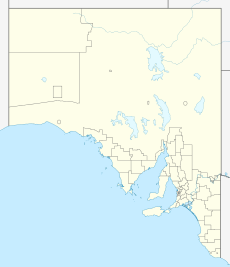Mount Dutton Bay Conservation Park facts for kids
Quick facts for kids Mount Dutton Bay Conservation ParkSouth Australia |
|
|---|---|
|
IUCN Category Ia (Strict Nature Reserve)
|
|
| Nearest town or city | Coffin Bay |
| Established | 16 March 1967 |
| Area | 9 ha (22 acres) |
| Managing authorities | Department for Environment and Water |
| See also | Protected areas of South Australia |
Mount Dutton Bay Conservation Park is a special protected area in the Australian state of South Australia. It is located on the west coast of the Eyre Peninsula. You can find it on islands in the waters near the town of Coffin Bay.
Contents
About Mount Dutton Bay Conservation Park
This conservation park is made up of several islands. These islands are found in different bays around Coffin Bay. These bays include Port Douglas, Mount Dutton Bay, and Kellidie Bay.
Where are the Islands?
Three of the islands are in Port Douglas. These are called The Brothers. There is also an unnamed group of islands west of Horse Peninsula. Rabbit Island is another island, located west of Coffin Bay town. Another island is at the north end of Mount Dutton Bay. Goat Island is just north of Coffin Bay town. It sits in the channel that connects Port Douglas to Kellidie Bay.
History of the Park
The land in this park was first protected on March 16, 1967. It was set aside as "fauna conservation reserves." This meant it was a safe place for animals. On April 27, 1972, it officially became the Mount Dutton Bay Conservation Park. This happened when the National Parks and Wildlife Act 1972 was put into law. On November 4, 1993, two more unnamed islands were added to the park. These islands are located west of Horse Peninsula. As of 2018, the park covers an area of 9 hectares (about 22 acres).
Why is it Protected?
In 1980, experts described the park as very important. These islands are special breeding grounds for seabirds. Some of these birds are quite rare. They include the reef heron, sooty oyster catcher, and different types of terns. Fairy penguins, pacific gulls, and silver gulls also use these islands. All five types of cormorants use the islands too. Large groups of black-faced and large pied cormorants roost here. Rock parrots, silvereyes, and the little grass bird also nest on these islands.
The islands are mostly made of limestone and sand. Most of the natural plants have been replaced by other grasses and shrubs. The islands are safe places for birds to breed and roost. This is because there are no predators (like foxes or cats) introduced by humans. One island, at the mouth of Dutton Bay, is connected to the mainland at low tide.
Park Classification
Mount Dutton Bay Conservation Park is a very strictly protected area. It is classified as an IUCN Category Ia protected area. This means it is a "Strict Nature Reserve." These areas are protected for scientific research and environmental monitoring. They are kept as wild as possible. In 1980, the park was also listed on the Register of the National Estate. This register no longer exists.


